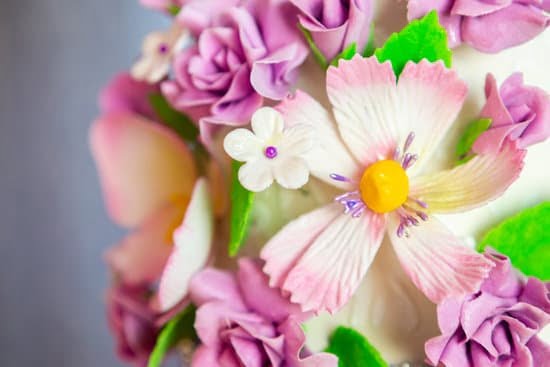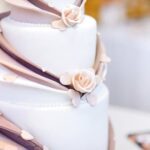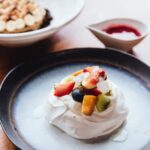Decorating a cake goes beyond just creating a visually appealing centerpiece. It involves intricate details and the art of bringing out the theme or occasion through design. One essential aspect of cake decoration that should never be overlooked is the cake border designs.
These designs serve as the final touch, adding elegance and sophistication to any cake creation. In this article, we will explore the importance of cake border designs and how they can elevate your cake decorating skills to new heights.
Cake border designs play a crucial role in completing the overall look of a cake. They serve as a beautiful frame that enhances the presentation and draws attention to the main focal point. Whether you’re designing a wedding cake or a birthday cake, having well-executed borders can instantly transform an ordinary-looking creation into something extraordinary.
Not only do cake border designs contribute aesthetically, but they also provide structure and stability to your cakes. Borders help keep frosting layers intact, preventing any mishaps during transportation or while cutting slices. Moreover, they act as a barrier between different elements on the cake. Thus, understanding various techniques for creating stunning borders is essential for both amateur bakers and seasoned professionals alike.
Types of Cake Border Designs
When it comes to decorating a cake, the border designs play a significant role in enhancing its overall appearance. The right cake border design can add that perfect finishing touch, elevating your cake from ordinary to extraordinary. There are several types of cake border designs that you can explore and experiment with, such as buttercream borders, fondant borders, and piped borders.
Buttercream borders offer a versatile range of designs and techniques that can be achieved using buttercream icing. Some popular buttercream border designs include the classic shell design, which involves creating a series of shells around the edges of the cake using a piping bag and a star-shaped piping tip.
Another popular design is the rope border, where even lines are piped around the outer edges of the cake to create a twisted rope-like effect. For those looking for a more whimsical touch, zigzag or scalloped buttercream borders can be created by piping diagonal or wavy lines along the edge of the cake.
Fondant borders provide endless opportunities for creativity and can be achieved using various molds and cutters. You can create intricate lace-like designs using lace molds or opt for simple geometric shapes using cookie cutters. Fondant allows for precise details and textures, making it perfect for adding dimension to your cake’s borders. To achieve a glamorous finish, consider embellishing your fondant borders with edible pearls, sequins, or other edible decorations that complement your cake’s theme.
Piped borders involve mastering basic piping techniques to create elegant designs on your cake’s edges. From simple dots or lines to intricate floral motifs and delicate lace patterns, there are countless possibilities when it comes to piped borders. To ensure consistency in your piping patterns, practice maintaining even pressure on the piping bag as you guide it along the edge of the cake. You can also use different piping tips to achieve various effects and thicknesses in your designs.
By exploring these different types of cake border designs, you can unleash your creativity and bring a personal touch to your cakes. Whether you prefer the versatility of buttercream, the precision of fondant, or the elegance of piping, the choice is yours. Remember to select the right tools, materials, and colors to accentuate your cake borders and create stunning masterpieces.
Tools and Materials Required
To create beautiful cake border designs, it is important to have the right tools and materials at hand. This section will outline the essential items needed for cake border designs, including piping tips, colors, and materials that will help accentuate your cake borders.
Firstly, let’s discuss the essential tools required for cake border designs. You will need a good quality piping bag, which can be reusable or disposable depending on your preference. A set of piping tips is also crucial in achieving different types of borders. Some popular options include the star tip for creating rosettes or stars, the round tip for basic borders and writing, and the leaf tip for adding foliage-like details.
In addition to piping tips and bags, you may also need couplers to easily change tips without having to empty and refill the bag each time. A coupler consists of two parts – a base that attaches to the bag and a ring that holds the tip in place. This allows you to switch between tips quickly and efficiently.
| Tip | Border Effect |
|---|---|
| Round Tip | Basic Borders |
| Star Tip | Rosettes or Stars |
| Leaf Tip | Foliage-like Details |
| Ruffle Tip | Ruffled Edges |
Lastly, choosing the right colors and materials is essential in accentuating your cake borders. Gel food colors are ideal for achieving vibrant shades in your buttercream or fondant. It is recommended to start with a small amount of color and gradually add more until you achieve the desired hue. Additionally, consider using edible embellishments such as pearls, sequins, or sprinkles to add sparkle and texture to your border designs.
By having the right tools and materials at your disposal, you will be well-equipped to tackle various cake border designs and create stunning finishing touches that will elevate the overall aesthetic of your cakes.
Preparing the Cake for Decoration
Before you can start decorating your cake with beautiful border designs, it is important to properly prepare the cake for decoration. This involves a few essential steps to ensure that you have a smooth surface and a sturdy base for your borders.
The first step in preparing the cake is to level the cake layers. This ensures that you have an even surface to work with, which is crucial for achieving clean and polished border designs. Use a serrated knife or a cake leveler to remove any domed tops from the cake layers, creating a flat and level surface.
Once your cake layers are leveled, it is time to apply a crumb coat. A crumb coat is a thin layer of frosting that seals in any loose crumbs on the cake, preventing them from interfering with your final decoration. Spread a thin layer of frosting all over the cake using an offset spatula, ensuring that every nook and cranny is covered.
After applying the crumb coat, it’s important to let it set before moving on to piping or applying fondant. Place the cake in the refrigerator for about 15-30 minutes, allowing the crumb coat to firm up. This will make it easier to achieve clean and precise borders without any crumbs getting in the way.
| Tools and Materials Required | Example |
|---|---|
| Serrated knife or cake leveler | – |
| Offset spatula | – |
| Frosting (for crumb coat) | – |
Now that your cake is leveled and has a crumb coat applied, you are ready to move on to the fun part – decorating your cake with beautiful border designs. Taking the time to properly prepare your cake ensures that your borders will have a professional and polished appearance. So don’t skip these important steps before diving into the artistic side of cake decoration.
Buttercream Border Techniques
When it comes to cake decoration, buttercream borders are a popular choice due to their versatility and delicious taste. There are several classic buttercream border designs that you can easily create to add a touch of elegance or whimsy to your cakes.
One of the most common buttercream border designs is the shell border. To achieve this design, start by holding a piping bag fitted with a star tip at a 45-degree angle. Squeeze the bag lightly and move it in a horizontal wave-like motion, creating small shells along the edge of your cake. Repeat this process all around the sides of the cake for a beautiful shell border.
Another popular buttercream border design is the rope border. This design gives your cake a neat and polished look. To create a rope border, hold a piping bag fitted with a round tip perpendicular to the surface of the cake. Start squeezing the bag while moving it in small circular motions, creating loops that resemble ropes. Continue this pattern around the edges of your cake for an elegant finish.
For those looking to add some texture and dimension to their cakes, consider trying out the zigzag design. Hold a piping bag fitted with a star tip at an angle to create diagonal lines across the surface of your cake. Alternate between squeezing and releasing pressure on the bag as you move along, creating peaks and valleys that form an attractive zigzag pattern.
To achieve smooth and precise buttercream borders, make sure you have practiced consistent pressure control while piping. Also, ensure that your buttercream icing is at the right consistency – not too stiff or too soft – for easy piping. Experimenting with different colors can also enhance your buttercream borders, whether it’s matching them with other elements on your cake or using contrasting shades for added visual interest.
With these simple techniques, you can easily master classic buttercream borders like shells, ropes, and zigzags, elevating your cake decoration game to a whole new level. Remember, practice is key, so don’t be afraid to experiment and find your own unique style. Happy decorating.
- Shell border
- Rope border
- Zigzag design
Fondant Border Ideas
Fondant is a versatile and popular medium for cake decoration, offering endless possibilities for creating unique and intricate designs. When it comes to cake border designs, fondant allows for the creation of stunning and eye-catching borders that can enhance the overall aesthetic of your cake. Here are some creative ideas for fondant cake borders:
- Creating Intricate Fondant Borders with Molds and Cutters: One of the easiest ways to create beautiful fondant borders is by using molds and cutters. These tools come in various shapes and sizes, allowing you to experiment with different patterns and designs.
You can use floral molds to make delicate flower borders or geometric cutters to create modern and clean lines. Make sure to dust your molds or cutters with icing sugar or cornstarch before using them to prevent sticking. - Adding Texture and Dimension to Fondant Cake Borders: Fondant offers a great opportunity to add texture and dimension to your cake borders. You can achieve this by using embossing mats or textured rolling pins.
Embossing mats are flexible sheets with raised patterns that can be pressed onto the fondant surface, while textured rolling pins have engraved patterns that leave imprints on the fondant as you roll over it. These techniques help create visually interesting borders that can make your cake stand out. - Using Edible Pearls, Sequins, and Other Embellishments: For a glamorous finish, consider adding edible pearls, sequins, or other embellishments to your fondant cake borders. Edible pearls come in different sizes and colors, allowing you to create elegant pearl accents along the border. Sequins made of edible materials can also be used creatively to add sparkle and shine. You can even experiment with other embellishments such as edible flowers or gold leaf for a more lavish look.
Remember always to plan your design beforehand by sketching it out or creating a template. This will help ensure accuracy in executing your fondant border design. Additionally, practice working with fondant to get a feel for its texture and elasticity before applying it to your cake.
With these fondant border ideas, you can take your cake decoration skills to the next level and create beautifully detailed borders that will impress your guests. Let your creativity run wild and experiment with different techniques and design elements until you achieve the perfect finishing touch for your cakes.
Piped Border Designs
Mastering Basic Piping Techniques
Piped border designs offer a wide range of possibilities when it comes to cake decoration. Mastering basic piping techniques is crucial for creating elegant and sophisticated border designs. The first step in this process is familiarizing yourself with the different types of piping tips available and understanding their effects on the final design.
For straight lines and borders, a round tip such as a size 2 or 3 can be used. This provides a clean and simple look to your cake border. If you prefer a more intricate design, consider using a star tip or a petal tip. These tips create textured and decorative edges that add flair to your cake borders.
Tips for Achieving Consistency
Consistency is key when it comes to piping beautiful borders on cakes. To ensure that your piped lines are consistent, it is important to practice pressure control. Applying consistent pressure while squeezing the piping bag ensures even flow of icing onto the cake.
Another useful tip is to maintain a steady hand movement. Keeping your hand steady while piping prevents wobbly lines or uneven spacing between pipe strokes. It may take some practice to achieve this level of control, but with time and patience, you will soon master the art of creating consistent piped borders.
Creating Decorative Details
One of the advantages of using piping for cake border designs is its versatility in creating decorative details. With just a few simple techniques, you can transform your piped borders into intricate bows, flowers, or lace patterns.
To create a bow design, start by piping two loops side by side with slightly pointed ends that meet at the center. Then pipe two tails extending downward from the center point of the loops. Add small dots or lines as desired to complete the bow design.
Flowers can also be easily created using piping techniques. Begin by piping a small dot in the center of the flower, and then pipe petals around it, using a gentle squeezing motion to create a curved shape. Varying the pressure applied while piping will give your flowers depth and dimension.
Lastly, if you want to add an elegant lace pattern to your cake border, use a fine round tip or a lace impression mat. Pipe intricate lace-like patterns onto the cake using royal icing for a delicate and sophisticated touch.
By mastering basic piping techniques, achieving consistency, and creating decorative details with piping, you can elevate your cake border designs to new levels of creativity and artistry.
Finishing Touches and Presentation
After diligently creating your cake border designs, it’s time to add those final touches that will elevate your cake to a whole new level. The finishing touches and presentation are crucial aspects of showcasing your beautifully decorated cake.
To add an extra touch of sparkle and glamour, consider using edible glitter, dust, or even edible paint. These can be applied delicately to highlight specific elements of the border designs or to add an overall shimmering effect to the cake. Edible glitter comes in various colors and sizes, allowing you to customize the look according to your design.
Presentation plays a vital role in showcasing your cake border designs. You have put so much effort into creating a masterpiece, so make sure it is displayed in a way that complements its beauty. Consider using a cake stand that suits the style of your cake – whether it be a sleek modern design or a vintage-inspired piece.
Additionally, think about the backdrop for your cake display. A simple tablecloth or a beautiful cake board can create a stunning canvas for your decorated cake. Remember to consider the theme or occasion when selecting these elements, ensuring they enhance the overall presentation.
Troubleshooting is inevitable when it comes to decorating cakes, but don’t let it dampen your spirits. If you encounter any common issues with your cake border designs, such as smudged buttercream or uneven piping lines, there are ways to fix them. For example, if you notice smudging on buttercream borders, use some clean fingertips or a small offset spatula dipped in warm water to gently smooth out any imperfections.
Conclusion
In conclusion, cake border designs are an essential aspect of cake decoration that add the perfect finishing touch to any cake. Throughout this article, we have explored various types of cake border designs such as buttercream, fondant, and piped borders. We have also discussed the tools and materials required for creating stunning cake borders, as well as tips for preparing the cake for decoration.
Furthermore, we have delved into specific techniques for creating beautiful buttercream borders, including classic designs like the shell, rope, and zigzag patterns. We have also provided ideas for intricate fondant borders using molds and cutters, as well as tips for adding texture and dimension to fondant cake borders. Additionally, we have explored basic piping techniques for elegant piped border designs and provided tips for achieving consistent patterns.
Finally, it is important to remember that your artistic flair can truly shine through in your cake border designs. Whether you choose buttercream, fondant, or piped borders, don’t be afraid to experiment and express your creativity. As you continue to practice and develop your skills, you will undoubtedly create stunning and unique cake border designs that showcase your own personal style.
Overall, decorating a cake with beautiful border designs is a delightful way to elevate your baking creations. Take inspiration from the tips and techniques shared in this article and let your imagination run wild.
Your friends and family will be amazed by your artistic talent when they see the stunning cake border designs you create. So go ahead and embrace this exciting aspect of cake decorating – it’s time to showcase your own personal brand of creativity through these eye-catching designs.
Frequently Asked Questions
How do you make designs on the side of a cake?
Making designs on the side of a cake requires precision and a steady hand. One popular method is to use a piping bag fitted with a small round tip. Begin by preparing your icing in the desired color and consistency, ensuring it is smooth and free of lumps. Hold the piping bag at a slight angle against the side of the cake, starting from the bottom and working your way up.
Apply gentle pressure to release the icing while moving your hand in a continuous motion. You can create various designs such as dots, lines, or even intricate patterns depending on your creativity and skill level. It’s crucial to practice beforehand to get comfortable with controlling the piping bag for more accurate and visually appealing designs.
How do you make a swirl border on a cake?
To create a swirl border on a cake, you will need a star-shaped piping tip and an icing bag filled with buttercream or any preferred frosting. Start by ensuring that the cake’s edges are clean and levelled with a thin layer of frosting as a base. Gently press the tip of your piping bag against one corner of the cake’s edge at an approximately 45-degree angle, nearer to the cake surface than higher up.
Squeeze out a small amount of icing while moving steadily along the edge, creating soft swirls by tracing semi-circular motions with your hand as you continue around the entire perimeter of the cake. This technique can add an elegant touch to any cake design, adding texture and visual interest.
How do you put designs on a cake?
Putting designs on a cake offers endless possibilities for creativity and personalization. One common approach is using fondant, which is like edible modeling clay that can be shaped into various forms such as flowers, figures, or intricate decorations. Roll out fondant on a clean surface dusted lightly with powdered sugar to prevent sticking, then cut it into shapes using cookie cutters or specialized fondant tools based on your desired design elements. Spread some buttercream frosting onto the surface where you want to attach the fondant design, acting as an adhesive.
Carefully place the fondant pieces onto the cake and gently press them to secure in place. Alternatively, you can also use edible food coloring pens or brushes to draw directly on a cake’s surface, creating intricate designs or writing personalized messages. For more elaborate designs or patterns, consider using stencils with powdered sugar or cocoa powder to create impressive decorations with precision and ease.

Welcome to our cake decorating blog! My name is Destiny Flores, and I am the proud owner of a cake decorating business named Cake Karma. Our mission is to provide delicious, beautiful cakes for all occasions. We specialize in creating custom cakes that are tailored specifically to each customer’s individual needs and tastes.





